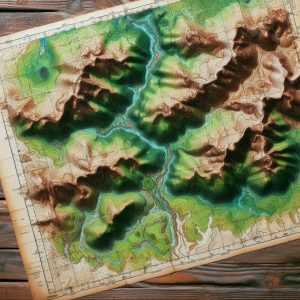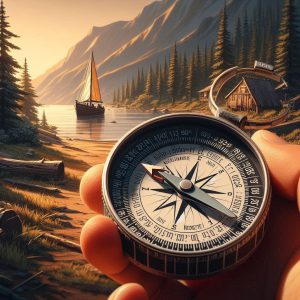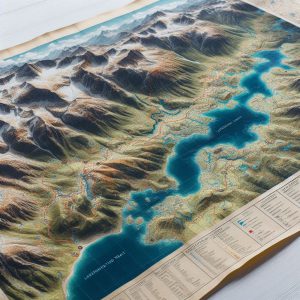Boost Your Wilderness Navigation Skills: Master Map and Compass Techniques Without GPS
Embarking on the adventure of mastering wilderness navigation without modern technology might seem daunting at first. However, acquiring essential map and compass navigation skills is a rewarding journey that profoundly enhances your outdoor experiences. At its core, effective navigation relies on a thorough understanding of your environment and the ability to accurately determine your position in relation to your destination. A map serves as a detailed representation of the terrain, while a compass provides a dependable method for orienting yourself according to the cardinal directions: north, south, east, and west. By mastering these critical navigational tools, you will gain the self-assurance to explore the wilderness on your own, liberated from the limitations of technology.
To begin your navigation journey, immerse yourself in the various symbols and scales found on a map; these elements are essential for accurately interpreting the physical landscape. Learning to read contour lines that indicate elevation changes is crucial, as this knowledge allows you to identify hills, valleys, and other geographical features that could influence your route. Additionally, becoming proficient with the compass is equally important, as it empowers you to navigate effectively in the wild without relying on GPS devices.
The compass needle consistently points toward magnetic north, enabling you to align your map with the actual landscape. To achieve this, hold the compass flat in your hand and rotate the map until the magnetic north on the compass aligns with the map’s north. This vital process, known as “orienting the map,” is fundamental for ensuring accuracy in your navigation efforts and confirming that you remain on the correct path.
Once you have successfully oriented your map, you can use the compass to take bearings that will guide your journey. By effectively combining these two powerful navigational tools—the map and the compass—you will navigate unknown terrains with confidence, ensuring that you stay on track even when modern technology is unavailable.
Key Principles for Mastering Effective Outdoor Navigation Techniques
- Developing proficiency in map and compass navigation is essential for anyone participating in wilderness exploration or outdoor activities.
- Topographic maps offer intricate insights into the terrain, elevation changes, and natural features, which are critical for successful navigation.
- A compass not only indicates direction but also helps in effective navigation by aligning with the map’s orientation and understanding magnetic north.
- Natural landmarks and cues, such as distinctive rock formations or unique tree patterns, can serve as invaluable navigational aids when you don’t have a map or compass.
- Estimating distance and travel time is vital for planning and executing a successful navigation strategy in the wilderness.
 The Indispensable Role of Topographic Maps in Wilderness Navigation
The Indispensable Role of Topographic Maps in Wilderness Navigation
Topographic maps are essential tools for anyone planning to explore the wilderness. They provide extensive information regarding the physical characteristics of the landscape, utilizing contour lines to depict changes in elevation. This representation allows you to visualize the shape and steepness of the terrain, thus aiding in your preparation for the challenges that lie ahead. Each contour line connects points of equal elevation, and the spacing between these lines indicates the steepness of slopes, equipping you with the necessary knowledge for effective navigation.
Mastering the Interpretation of Contour Lines and Map Symbols for Enhanced Navigation
As you examine a topographic map, it is crucial to carefully observe the patterns formed by contour lines; closely spaced lines indicate steep terrain, while widely spaced lines suggest flatter areas. This understanding will empower you to anticipate potential obstacles along your route, enabling informed navigation decisions. Furthermore, topographic maps are filled with symbols that represent various landmarks, including rivers, roads, trails, and different types of vegetation. Familiarizing yourself with these symbols is vital for successful navigation, ensuring that you can effectively utilize the map throughout your journey.
Implementing Effective Navigation Techniques Using Topographic Maps
For instance, blue lines typically signify the existence of water bodies like streams or lakes, while green areas may indicate forests or dense vegetation. By cross-referencing these symbols with your real-world surroundings, you can verify your location and make necessary route adjustments. Additionally, topographic maps often include grid lines that assist in pinpointing coordinates, leading to even more precise navigation. By mastering the complexities of topographic maps, you will deepen your appreciation for the landscape while enhancing your overall navigational skills in the wilderness.
 Leveraging Compass Techniques for Accurate Directional Navigation
Leveraging Compass Techniques for Accurate Directional Navigation
A compass is an indispensable tool for any adventurer, serving as a crucial aid for directional navigation, especially in unfamiliar landscapes. To utilize a compass effectively, start by holding it level in front of you and allowing the needle to settle. The needle points toward magnetic north, which can vary slightly from true north due to magnetic declination—the angle between magnetic north and true north changes based on your geographical location.
Before embarking on your journey, it is essential to determine the local declination and adjust your compass accordingly. This adjustment ensures that your bearings remain accurate, aiding you in staying on course throughout your adventure. Once your compass is calibrated for declination, you can proceed to take a bearing that will guide your direction of travel.
To take a bearing, identify a landmark you wish to navigate toward and rotate the compass housing until the orienting arrow aligns with the magnetic needle. The degree reading on the compass dial that aligns with the index line indicates your bearing. As you advance toward your destination, it is advisable to periodically check your bearing to confirm that you are maintaining your intended course.
If you find yourself drifting off course, reorient your compass and adjust your path as necessary. By mastering these techniques, you will cultivate the confidence to rely on a compass as a trustworthy navigational tool during any outdoor excursion.
 Utilizing Natural Landmarks and Cues for Superior Navigation
Utilizing Natural Landmarks and Cues for Superior Navigation
While maps and compasses are fundamental navigational tools, keenly observing natural landmarks and signs can significantly enhance your ability to navigate the wilderness effectively. Distinctive features such as mountains, rivers, or unique trees can serve as invaluable reference points when traversing unfamiliar terrain. For instance, if you know a particular mountain is located to the east of your starting point, you can use it as a guiding reference to ensure you are traveling in the correct direction.
Moreover, familiarizing yourself with the unique characteristics of your environment helps in creating mental maps that enable navigation without solely relying on tools. Besides prominent landmarks, be attentive to natural signs that can indicate direction or changes in terrain. The sun’s position can serve as a helpful guide; in the northern hemisphere, the sun rises in the east and sets in the west, providing a general sense of direction throughout the day.
Additionally, observing the growth patterns of moss on trees—often denser on the north side—can provide valuable orientation clues in dense forests. Animal trails can also serve as directional hints; many animals follow established paths that can lead you toward water sources or other significant landmarks. By sharpening your ability to interpret these natural signs, you will become increasingly adept at navigating through diverse environments.
Mastering the Art of Distance Estimation and Travel Time Calculation for Successful Navigation
Accurately estimating distance and travel time is vital for effective navigation in wilderness areas. Understanding how far you have traveled and how long it will take to reach your destination allows for improved planning and helps avoid unexpected obstacles. One practical technique for estimating distance involves pacing—counting your steps as you walk.
On average, an adult’s stride measures approximately 2.5 feet, which means that by counting your steps over a known distance, you can gauge how far you’ve traveled based on your pace. Additionally, consider the type of terrain and any elevation changes when calculating travel time. For example, traversing flat ground typically allows for quicker movement compared to navigating steep hills or rocky paths.
A common guideline suggests estimating that you can cover roughly three miles per hour on flat terrain; however, this estimate should be significantly adjusted when facing challenging landscapes. By taking these variables into account and adapting your expectations accordingly, you will be better prepared for your journey and more capable of managing your time effectively.
Formulating a Strategic Wilderness Route and Navigation Plan for Successful Exploration
Creating a Comprehensive Wilderness Route for Effective Navigation
Developing an effective navigation plan is crucial before embarking on any wilderness adventure. Start by studying topographic maps of the area you plan to explore, identifying potential routes based on notable landmarks, existing trails, and accessible water sources. As you outline your route, consider factors such as elevation changes and the difficulty level of the terrain; ensuring your plan is both realistic and achievable is of utmost importance.
Preparing for Unexpected Obstacles and Environmental Changes During Your Journey
While planning your route, it is prudent to consider alternative paths in case you encounter unexpected obstructions or sudden weather changes. Having multiple options readily available will provide you with greater flexibility during your journey and contribute to your safety. This adaptability is essential for a successful and enjoyable wilderness experience, allowing you to navigate challenges that may arise with ease.
Crafting a Comprehensive Navigation Strategy for Wilderness Adventures
After mapping out potential routes, create a detailed navigation plan that includes critical waypoints. Mark these waypoints on your map and, if possible, record their coordinates, enabling you to monitor your progress as you navigate through the wilderness. Additionally, factor in estimated travel time between waypoints and identify any potential hazards you may encounter along your chosen route.
Ensuring a Safe and Rewarding Outdoor Experience Through Thorough Planning
Meticulous planning and anticipating challenges will enhance your chances of reaching your destination while enjoying a safe and fulfilling outdoor experience. A well-structured navigation strategy is vital for a successful wilderness adventure, ensuring that you can explore the great outdoors with confidence and assurance.
 Leveraging Emergency Navigation Techniques for Unforeseen Scenarios in the Wilderness
Leveraging Emergency Navigation Techniques for Unforeseen Scenarios in the Wilderness
Even with careful planning and preparation, unforeseen circumstances may arise during outdoor adventures that necessitate emergency navigation techniques. One vital skill is the ability to backtrack; if you find yourself lost or disoriented, retracing your steps can often lead you back to familiar territory. To execute this effectively, pay close attention to distinctive landmarks or features along your route, which can serve as reference points when returning.
Another invaluable technique is celestial navigation, particularly useful when visibility allows—especially on clear nights or sunny days when stars or celestial bodies are observable. Familiarizing yourself with prominent constellations, such as the North Star (Polaris) in the northern hemisphere, can provide guidance, as it remains relatively fixed in position while other stars shift. By locating Polaris and determining its angle above the horizon, you can ascertain true north, even in the absence of a compass or map.
If you have a watch or smartphone as a backup, utilizing it alongside celestial navigation can reinforce your sense of direction during emergencies, helping you maintain your orientation even in challenging situations.
Enhancing Your Wilderness Navigation Skills: Practical Strategies for Continuous Improvement
Improving your wilderness navigation skills requires commitment and practice, but the rewards can significantly enrich your outdoor experiences. One effective approach is to join local hiking groups or outdoor clubs, where members can share their knowledge and experiences regarding navigation techniques. Engaging with seasoned navigators can provide invaluable insights into best practices while offering hands-on learning opportunities across diverse terrains.
Another beneficial strategy involves regularly practicing with maps and compasses in various environments—whether in urban settings or remote wilderness areas—to build your confidence in these skills. Allocate time for solo excursions where you intentionally navigate without the aid of technology; this approach will reinforce your abilities while allowing you to connect more deeply with nature. Additionally, consider maintaining a navigation journal to document routes taken, challenges faced, and lessons learned during each adventure; this reflective practice will not only enhance your skills but also deepen your appreciation for navigating diverse landscapes.
By embracing these techniques and continually refining your abilities in map reading, compass usage, natural observation, distance estimation, route planning, emergency strategies, and sharing practical experiences with others, you will evolve into a more self-assured navigator, capable of thriving in any wilderness environment, even without the support of technology.
Your Questions Answered: Common FAQs About Wilderness Navigation Techniques
What is involved in wilderness navigation?
Wilderness navigation encompasses the necessary skills to determine and maintain a route through natural, often remote, and undeveloped areas. It involves utilizing various tools and techniques to stay on course and safely reach your desired destination.
What traditional methods are used in wilderness navigation?
Traditional methods of wilderness navigation include using a map and compass, interpreting topographic features, observing natural landmarks, and employing celestial navigation techniques based on the sun, moon, and stars.
Why might someone prefer to navigate without GPS?
Many individuals choose to navigate without GPS for several reasons, including the desire to enhance their wilderness navigation skills, embrace the challenge of traditional methods, or prepare for potential GPS failures or limited access to technology.
What are the benefits of learning wilderness navigation without relying on GPS?
Learning wilderness navigation techniques without GPS can deepen one’s understanding of the natural environment, increase self-reliance and confidence, and provide a backup plan in case of technology failures or limited access to GPS devices.
What challenges may arise when navigating in the wilderness without GPS?
Challenges associated with wilderness navigation without GPS include the need for advanced planning, potential for human error, and reliance on environmental conditions such as weather and visibility.
The post Wilderness Navigation Techniques Without GPS appeared first on Survival Bite.
The Article Wilderness Navigation Techniques for Off-Grid Adventures Was Found On https://limitsofstrategy.com

Your exploration of map and compass techniques as a means to enhance wilderness navigation is both timely and thought-provoking. In an age so saturated with technology, where even our phones can provide real-time locations and directions, it’s refreshing to hear a call to return to the art of traditional navigation. I find that this skill not only rekindles a profound connection to nature but also fosters a sense of self-reliance that is often diminished in our tech-centric lives.
You’ve touched on something really important and close to my heart. The contrast between map and compass navigation and our reliance on smartphones is fascinating. I often find that stepping away from technology can be grounding in more ways than one. There’s a quiet confidence that comes from understanding how to read a terrain without the constant ping of a device.
I recently came across an insightful piece that delves into bushcraft skills, emphasizing how they can enhance our self-reliance and deepen our connection to the outdoors, much like the traditional navigation techniques you mentioned.
‘Survival and Self-Reliance Through Bushcraft Skills’
https://seopitstop.co.uk/survival-and-self-reliance-through-bushcraft-skills/.
I really appreciate your thoughts on the contrast between traditional navigation methods and our current dependence on smartphones. There’s something undeniably satisfying about being out in nature, equipped only with a map and compass. It feels like tapping into an ancient skill set that connects us with exploration in a way that digital devices often can’t replicate.
Your insights into the mastery of map and compass navigation resonate deeply with me, particularly in a time when reliance on GPS technology has become ubiquitous. I fondly recall a camping trip I took several years ago in the backcountry of the Rockies. Faced with thick fog one morning, our group’s reliance on our smartphones quickly proved unwise as signals dwindled. It was at that point that a fellow hiker’s mastery of traditional navigation tools saved us, guiding us back to our planned route using just a map and a compass.